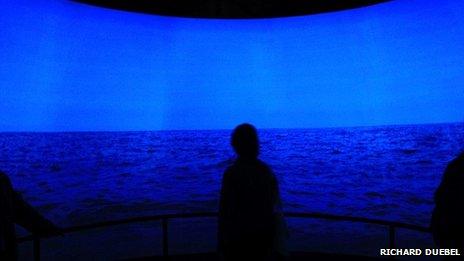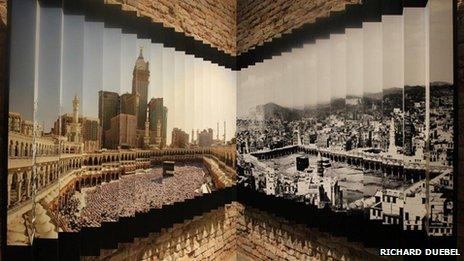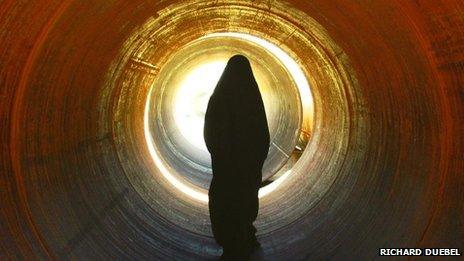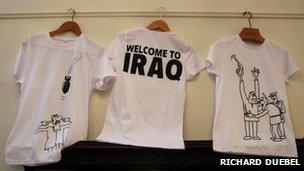Venice Biennale hosts largest ever presence of Arab art
- Published

Walking on Water by Mohammed Khazem
Arab nations are represented more than ever at the current Venice Biennale, displaying a wide range of art from the Middle East.
As a group of visitors walk out of the United Arab Emirates (UAE) pavilion at this year's Venice Biennale decidedly unsteady on their feet, they reach out for the hand rail thoughtfully placed on both sides of the ramp to guide them back on "shore".
This is a rather unexpected side effect of the UAE installation called Walking on Water, since the pavilion sits firmly on dry land.
The sea-sickness is due in large part to innovative technology that immerses onlookers in choppy sea water with 15 projectors filling a large room floor to ceiling with 360 degree images of the Arabian Gulf.
Artist Mohammed Khazem says the theme - made with the help of a British software developer - is appropriate for Venice with its watery foundations.

Mariam Haji draws on Middle Eastern fascination with Arabian stallions in her work The Victory
"I am referring to the boundless nature of the sea," he explains. "Ten years ago I cast pieces of wood into the water off Dubai. By now they will have drifted across many borders and their actual location is unknown to me."
This technological tour-de-force is not the only digitally-driven Arab art work in this year's 55th Venice Biennale, the world's most important art fair.
Society on the move
Saudi Arabia's collateral event Rhizoma (Generation in Waiting) shows works by 26 young and largely unknown artists in a cavernous former salt depot near the old customs house, playing with the idea of unearthing potential great artists of the future at an early stage of their development.
It also reveals the forces that are shaping a society on the move, interweaving traditional skills such as calligraphy with technology, photography, video and installation art.
Co-curator Ashraf Fayadh says the exhibition reinforces the idea that, while the internet is the motor of Saudi Arabian communication, there is still a deeply-rooted religious awareness.
"We invited two media groups to create a billboard called The State of Social Media," he says. "It has some surprising facts about internet use."
Perhaps the most arresting is that Saudia Arabia watches more videos on YouTube every day than any other nation - some 90 million.

Wijha 2:148 And Everyone Has A Direction To Which He Should Turn by Ahmed Angawi
But this screen-age Arabia is balanced by the more sober work of Ahmed Angawi, whose work is titled Wijha 2:148 And Everyone Has A Direction To Which He Should Turn.
It throws into stark relief the architectural changes that are transforming the skyline of Mecca by juxtaposing a photograph of the Holy city taken in 1890 with one snapped earlier this year.
This comparison is taken further in Angawi's related piece, 21st Century Makkah Manuscript.
"I made a copy of a 17th Century Hajj certificate that is, in turn, a copy of a 12th Century document," he explains. "The piece shows the Holy Mosque with intricate the geometric patterns. But I have also added a tiny bulldozer in the bottom corner that is tearing into the Ottoman architecture."
In order to see the fine detail on the Hajj certificate which is placed on a lectern facing Mecca, visitors are obliged to incline in the direction of the Qaab'a.
While the pavilions of Kuwait and Syria steer clear of overt political comment, the exhibition by Egypt, the country with the longest ties to the Biennale (stretching back to 1938) reflects political unrest back home.
Its permanent pavilion shows large sculptures referring back to pre-Islamic times.
Among them is a bronze whirling dervish - a dig at the appointment of a new Egyptian minister of culture, who has come under widespread criticism for cramping artistic expression and sparked a series of high profile resignations which in turn, provoked a strike at the Cairo Opera.

A Villager's Day Out by Waheeda Malullah, sees a village girl posing in different urban settings
Among 10 newcomers to Venice is the Kingdom of Bahrain. Its debut exhibition shows personal insights by three artists.
Photographer Waheeda Malullah contrasts town and country by bringing a village girl to pose in different urban settings of the capital, Manama.
She asks if the simplicity of village life will be swamped by the industrial landscape, which mirrors concerns at the rapidly expanding high rise urban environment.
While Mariam Haji draws stampeding horses that have human expressions, drawing on Middle Eastern fascination with Arabian stallions.
And Lebanese-born Camille Zakharia fills two walls with decorative tiles, creating a personal collage of intimate correspondence between the artist and his mother during the Lebanese civil war, intermingling them with snapshots of his life over the last decades.
"It is very much about my life," he says. "But everyone can relate to a visit to the beach and the exchange of letters with a loved one who is no longer alive."

T shirts on display show satirical cartoons by Abdul Raheem Yassir
Taking the personal approach one step further is the Iraqi pavilion, a stone's throw from the Grand Canal.
It brings together 11 artists discovered by curator Jonathan Watkins as he toured the country in an armoured vehicle accompanied by armed security guards.
He has set up a traditional salon offering a chance to relax, read books on Iraq, drink tea and listen to live music by oud players.
Here they can look at photographs and a video by Kurdish artist Ahmed Penjweny, which conveys the impression Saddam Hussein is still very much in people's minds.
Welcome to Iraq also shows the poignant black and white satirical cartoons by veteran political commentator Abdul Raheem Yassir, that poke fun at bureaucracy in post-Saddam Iraq.
Although there has been an Arab presence in Venice for seven decades, there has never been such a wide variety of art produced by artists from so many different countries.
Collectively, this year's crop are demonstrating they are willing to confront the concerns and demands of a young Arab generation head on.
- Published6 June 2013
- Published3 June 2013
- Published30 May 2013
- Published29 May 2013